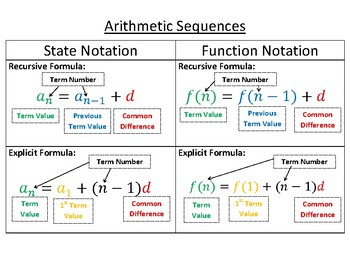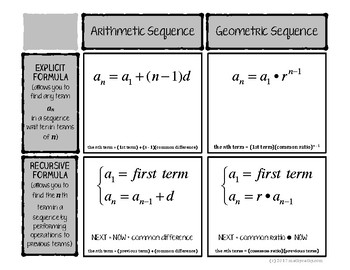
(TOP) Alternating positive and negative areas.
Arithmetic and geometric sequences and series formulas pdf series#
Rate of convergence Converging alternating geometric series with common ratio r = -1/2 and coefficient a = 1. In the limit, as the number of trapezoids approaches infinity, the white triangle remainder vanishes as it is filled by trapezoids and therefore s n converges to s, provided | r|1, the trapezoid areas representing the terms of the series instead get progressively wider and taller and farther from the origin, not converging to the origin and not converging as a series. The trapezoid areas (i.e., the values of the terms) get progressively thinner and shorter and closer to the origin. Each additional term in the partial series reduces the area of that white triangle remainder by the area of the trapezoid representing the added term. The area of the white triangle is the series remainder = s − s n = ar n+1 / (1 − r). For example, the series 1 2 + 1 4 + 1 8 + 1 16 + ⋯ Īlternatively, a geometric interpretation of the convergence is shown in the adjacent diagram. In mathematics, a geometric series is the sum of an infinite number of terms that have a constant ratio between successive terms. The total purple area is S = a / (1 - r) = (4/9) / (1 - (1/9)) = 1/2, which can be confirmed by observing that the unit square is partitioned into an infinite number of L-shaped areas each with four purple squares and four yellow squares, which is half purple.

Another geometric series (coefficient a = 4/9 and common ratio r = 1/9) shown as areas of purple squares.

The sum of the areas of the purple squares is one third of the area of the large square. Each of the purple squares has 1/4 of the area of the next larger square (1/2× 1/2 = 1/4, 1/4×1/4 = 1/16, etc.). Sum of an (infinite) geometric progression The geometric series 1/4 + 1/16 + 1/64 + 1/256 +.


 0 kommentar(er)
0 kommentar(er)
